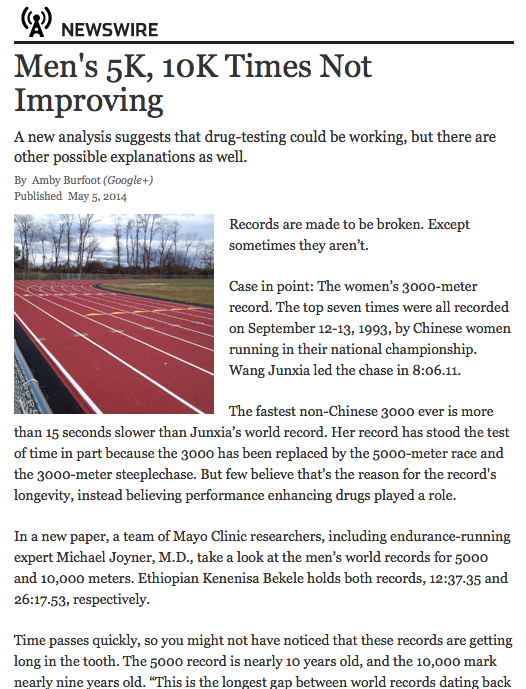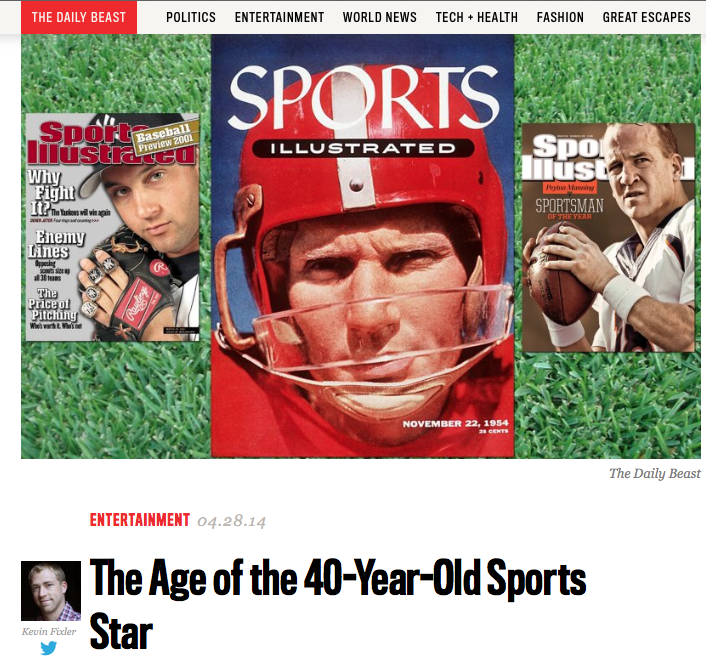Archive for May, 2014
Old and Unexciting Exercise Solutions
Last weekend in the Sunday Review section of the New York Times, Daniel Duane provided a personal narrative about how he adopted an old school and trainerless approach to weight lifting and essentially “got in shape” in his early 40s. This raises questions about what is old and unexciting in the field of exercise.
Consistency and progression matter.
The first thing you notice about all effective fitness programs is that consistency matters. People who get in better shape exercise regularly. After people start to get in shape the ones who get in better shape have a progressive program. In other words, as they get stronger they lift heavier weights, or as their endurance improves they run faster and farther. The before and after testimonial pictures seen on websites and infomercials all feature people who have actually done the program.
A couple of years ago the author and radio personality Peter Sagal wanted to improve his marathon time and he describes the advice I gave him:
I laid out my vitals for Dr. Joyner–5′ 7″, 175 pounds, 20 to 25 miles of running a week–and he expressed his wisdom simply and brutally: If I wanted to bend the arc of my performance back upward, I’d have to (A) run more, (B) lose weight, and (C) run a lot more. Joyner’s research showed that slowing the ravages of time was possible, but only with intense effort.
It worked and he set a personal record of 3:09 in his later 40s.
High Intensity Training (HIT) is an old idea.
I am not sure how many waves of enthusiasm there have been for HIT over the last 100 years. However, one of the most notable was promulgated in the 1970s by a serial innovator and promoter named Arthur Jones who developed Nautilus Machines. Read what he wrote in the 1970s and ask yourself what is new? For those interested in HIT and endurance, the training of Glenn Cunningham who held world record holder in the mile (4:06.8) during the middle 1930s anticipates current programs by about 80 years.
Calisthenics work!
In the late 1950s, the Royal Canadian Air Force got concerned about the poor physical fitness of pilots stationed in isolated bases in the far north with limited fitness facilities. To solve this problem RCAF developed a simple program of five basic exercises (5BX) that worked and could be done in 11 minutes per day. The program also encouraged people to build as much physical activity into their days as possible. A CBC radio interview with Wing Commander J.K. Tett of the RCAF from sometime in the 1960s emphasizes guess what, the role of consistency and progression in making the plan work.
The pull-up program used by many members of the U.S. Marine Corps to score well on the Marine fitness test is another example of what is possible with a simple, consistent and progressive approach to training. When people ask me about strength training I tell them when in doubt do push-ups, pull-ups and burpees.
Complicating the simple?
So, why the drive complicate the simple? In an e-mail exchange on the Duane story, Amby Burfoot the winner of the 1968 marathon commented that he was:
…struck by the comment about trainers who have an investment in making their advice as complex and lingo-heavy as possible. I’ve thought this for a long time, and of course practiced it as editor of a magazine that had accountants looking over my shoulder….. we need a term for this. I was thinking educate vs complexicate but that doesn’t include the important financial angle. The definition would be ‘make a subject as complicated and lingo-driven as possible in an effort to enhance one’s seeming knowledge and financial value as an “expert’ teacher in the field’…….
I think Amby is onto something and in addition to fitness, efforts to complexicate things are also at work for conceptually simple things like weight loss and healthy aging. My guess is that similar efforts to complexicate also drive the culture of consultants who offer advice to clients in many fields, but I will leave that to economists, social scientists and management gurus to explain. Can they do it in plain language in less than 1,000 words?
My Graduation Speech
Last week I had the privilege of giving a commencement address to several hundred graduates from the Department of Integrative Physiology at the University of Colorado, Boulder. I was invited to speak by Dr. Roger Enoka the department chair, who is a world leader in the study of human movement and muscle fatigue, and I was hosted by Dr. Douglas Seals who is world leader in the study of human aging. Roger and Doug have been friends and colleague for more than 30 years. The venue for the address was the beautiful neo-gothic Macky Auditorium on the University of Colorado Campus which dates from the early 1900s. I don’t have a transcript of the talk, but here is what I covered in about 10 minutes on a beautiful spring afternoon in Colorado.
Something Different
Most graduation talks have themes like:
- Our generation has screwed the world up pretty incredibly and we look forward to dumping the mess we made on you guys to solve……
- You think our generation has screwed the world up pretty incredibly but welcome to adulthood so you can see how hard it really is……. We really have been trying.
- How I “made it” by walking 4 miles uphill both directions barefoot in the snow to elementary school……
- Or, the generic be a better humanitarian lecture……
However, I wanted to do something different, so I focused on five lessons and ideas I have picked up over the years. Many of these lessons I saw in action in the person of John T. Shepherd who was my teacher and Sensei when I first came to the Mayo Clinic. The five lessons go something like this:
- Have 1 sharp knife
- Questions & energy are more important than answers
- Master money before it masters you
- Lead from behind
- Learn to ignore
Have 1 Sharp Knife
This lesson is pretty simple and it is about being good at something and engaging your passion. In other words don’t feel compelled to be well rounded. Having a “sharp knife” is especially important as life and work catch up with you and all sorts of potential distractions impinge on your focus. Also, if you can master one thing you will develop a generic set of skills that can be applied as you pursue excellence in other areas.
Questions & Energy Count More Than Answers
Usually school is about mastering information, facts and concepts. However knowledge and ideas and the “right answer” turn over. In medicine for example perhaps 30-40% of what is state of the art care is superseded every 10 years. I am sure this happens in other fields, so if you want to stay at the cutting edge you need to ask good questions and be prepared to have old ideas and dogmas replaced.
Master Money Before it Masters You
We live in a world obsessed with metrics and return on investment thinking. Slogans like “you can’t manage what you can’t measure” abound. However, my guess is that what you can’t measure is what differentiates the outstanding from the good or even success from failure. The other thing we should all remember is that rather than obsessing about what we can afford to do perhaps we should ask if we can afford to not do something. To me embracing calculated risks vs. worrying too much about resources seems like a better way to live.
Lead From Behind
Under most circumstances most of us are not the smartest, wisest, or most experienced people in the room. If you commit yourself to harvesting and facilitating the good ideas of others and delegating authority you will be “more successful” and you will be part of a team that can do way more than any individual can. Some of the best and most innovative people in history like Steve Jobs have essentially stolen, borrowed and/or adapted the ideas of others to great effect. If you can do these things in an inclusive way like John Shepherd could you will be even farther ahead. Additionally, you will be able to lead no matter where you are in an organizational hierarchy via the leverage you generate.
Learn To Ignore
Higher education is about learning to learn, but at least part of life is about learning to ignore. Ignore your own self-doubts. Ignore the ankle biters who are waiting for you and others to fail and be simply average. Also we all need to learn to ignore the difficult side of talented people we might be working with. Frequently talented people are hard driving and passionate. They care, but they can also have ego-centric and difficult sides and resist micro-management. Thus, the question is can you work with these people in a way that their egos are levers and not barriers? This is difficult, it takes patience, and it takes self-control. However, if you can take a calculated risk and help the truly talented get beyond their own egos and chase their dreams there is an upside for everyone. Good coaches understand the value of getting their best players more touches.
Closing Thought
As you look over the five lessons above, I am sure you can see that they are all connected, but a phrase I have heard from my wife (that she heard from her dad) is that “no one cares how much you know until they know how much you care”. When I think of the five lessons it seems to me that one way or another they are all connected by caring.
How Old is Meb?
The celebration surrounding Meb Keflezighi’s unexpected and inspiring victory at the Boston Marathon a few weeks ago is winding down. Beyond the social significance of his victory, his win at almost 39 years of age raises questions about just how old is “old” at the highest levels of athletic competition. I have been interested in this topic for some time, and whenever an athlete in their late 30s or early 40s does something remarkable my medical colleagues and the media start asking just how unique and exceptional performances by such “old” people are. For example in 2008 there was a wave of interest in this topic when the then 41 year old swimmer Dara Torres was preparing for the Olympics (she won a silver in the 50m freestyle). Here are five thoughts that hopefully can put Meb’s win and age in perspective.
First, some data about Meb’s time at Boston where he ran 2:08:37. This is important because there was a nutty piece in the Wall Street Journal suggesting that a sandbagging conspiracy by the other runners let him win with a slow time. In 1975 Bill Rogers was the first man to run the Boston in less than 2:10. Starting in 75 the winning time has been greater than 2:10 a total of 14 times, between 2:09 and 2:10 twelve times, between 2:08 and 2:09 six times, and faster than 2:08 only 6 times. If you look at the winning times at Boston since 1975, with the exception of a couple of outlier years in 2010 and 2011, they have been remarkably stable and Meb’s time would have won 14 of the last 20 races. Over this time Kenyans and Ethiopians won 18 of 20 races. In 2011 there was also a major tailwind that clearly explains the times in the 2:03s that year. If the over/under betting line at Boston is 2:08 next year, I will bet over.
The second issue is why did the pack let Meb get away and open up a lead via high risk front running? My guess is that many of the top runners did not realize just how fast 2:08 is at Boston, and they figured they could run Meb down later. This is problematic because the first two-thirds of the course is downhill and going downhill for that long that fast takes the snap right out of even the fastest runners legs. There is also precedent for front running in major marathons. Frank Shorter used similar tactics when he won the gold medal at Munich in 1972, and the story of that race is told beautifully by Kenny Moore (the 4th place finisher) in a piece he wrote for Sports Illustrated. My bet is that when he took off and no one chased a sort of groupthink set into the lead pack while they waited for him to fade a few miles down the road.
Third, Meb is not the first fast old guy. The great Ethiopian Mamo Wolde was 36 or 37 when he won gold in 1968 and 40 or 41 when he won the bronze at Munich in 1972. Carlos Lopes won the 1984 Olympic marathon at age 37 and a year later was the first man under 2:08. In the 1970s Jack Foster did well in Olympics in his early 40s and won the Honolulu Marathon at 43. At age 41 he went 2:11 and won a silver medal at the Commonwealth games. The women’s marathon in Bejing was won by 38 year old Constantina Diţă of Romania. The current masters world record is held by Andres Espinosa of Mexico who ran 2:08:46 at age 40 in 2003. All of these performances are remarkable and a 2:08 marathon is the equivalent of a 100m time of about 10 seconds flat or a mile of about 3:51.
Fourth, how is this possible? It turns out the major determinants of distance running performance including maximal oxygen consumption can be remarkably well preserved up to about age 40 and beyond, provided there is an adequate training stimulus including a lot of fast running. Motivation is also a key and the emergence of prize money and sponsorship over the last 20 or 30 years (Meb won $100,000 at Boston) has likely encouraged people to keep training and competing for longer. Improvements in sports medicine also make it easier for people to recover from injuries that were once career ending.
Fifth, don’t forget aging in other sports? When you get beyond distance running all sorts of other examples emerge like Julius Boros winning the PGA golf championship when he was 48, Ted Williams hitting 388 at age 38, and Warren Spahn winning 23 games in the major leagues when he was 42. Randy Johnson pitched a perfect game at age 40. There is also a long list of ice hockey players who have done well in their 40s, and don’t forget about boxers like Archie Moore and Bernard Hopkins who won championships in their late 40s. You can argue that the golf and baseball examples don’t count as much because these sports are more about skill and experience than conditioning, but you have to be in shape to play hockey and box. Incredibly, Chris Horner won the Vuelta a España cycling race at age 42 in 2013. If space were unlimited I could go on and on with examples.
Where will it all end? My guess is that we are going to see the number of people in their late 30s and early 40s who do well at the highest level of sport continue to grow, and it is just a matter of time until someone over 40 wins a major marathon or joins Mamo Wolde with an Olympic medal. It is also just a matter of time until someone over 50 wins a major golf championship (Tom Watson got 2nd at the British Open at age 59 in 2009) or perhaps pitches in and wins a World Series game. As the original ageless athlete Satchel Paige asked, “How old would you be if you didn’t know how old you are?” For Meb Keflezighi, and many others, the answer is we just don’t know.
You are currently browsing the Human Limits blog archives for May, 2014.




